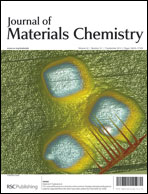A chemical self-assembled synthesis was used to prepare disordered porous semicrystalline WO3-based cathodic electrochromic films. The resulting films were characterized with transmission electron microscopy (TEM), scanning electron microscopy (SEM), X-ray diffraction (XRD), X-ray photoelectron spectroscopy (XPS), N2 physisorption, Fourier transform infrared spectroscopy (FTIR) and near-edge X-ray absorption fine structure (NEXAFS). The electrochromic performance was evaluated in a Li-ion electrolyte (i.e., 1 M LiClO4 dissolved in propylene carbonate) with cyclic voltammetry (CV), galvanostatic cycling with potential limitation (GCPL) and chronoamperometry (CA) techniques. It is demonstrated that the crystallinity of WO3 thin films can be readily tuned with the variation of annealing temperatures and TiO2 addition. The results demonstrated excellent stability and durability (i.e., 1500 GCPL cycles in 32 days) for WO3 electrode annealed at 350 °C, ultrafast switching kinetics for WO3–TiO2 electrode (i.e., bleaching and coloration times are 5.5 s and 4.2 s, respectively) and excellent charge reversibility (%R ≈ 100%). Electrochemical, TEM and Raman spectroscopy studies suggest that a change in degree of crystallinity in WO3 occurs during the extended durability test, which then influences the durability and switching kinetics.

You have access to this article
 Please wait while we load your content...
Something went wrong. Try again?
Please wait while we load your content...
Something went wrong. Try again?


 Please wait while we load your content...
Please wait while we load your content...